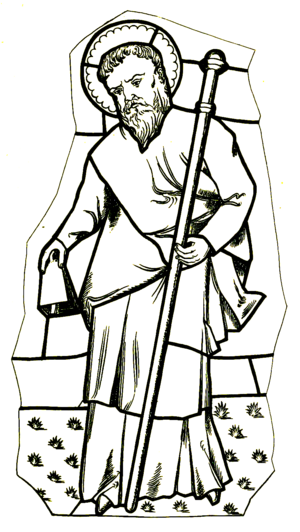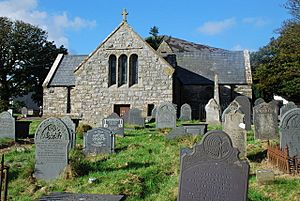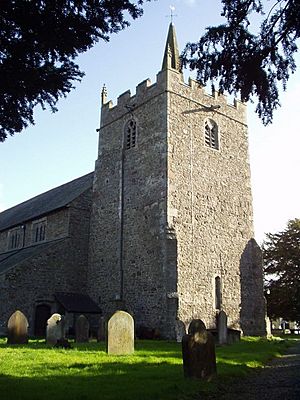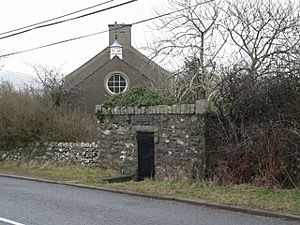Aelhaiarn facts for kids
Quick facts for kids Saint Aelhaiarn |
|
|---|---|

Saint Aelhaiarn with a cowbell (from a 15th-century stained-glass window in Plogonnec, Brittany)
|
|
| Born | Powys |
| Died | 7th century Llŷn |
| Canonized | Pre-Congregation |
| Major shrine | Guilsfield Llanaelhaearn |
| Feast | 2 November (lapsed) |
| Patronage | Guilsfield Llanaelhaearn |
Saint Aelhaiarn (pronounced Eye-l-hy-arn) was a Welsh saint from the early 7th century. His name in Welsh means "Iron Eyebrows". He was a follower of Saint Beuno, another important Welsh saint.
Aelhaiarn is remembered as a "confessor," which means he lived a holy life and openly showed his Christian faith. His special day, called a feast day, was usually celebrated on November 2nd. However, this day is no longer officially observed by churches in Wales.
Who Was Saint Aelhaiarn?
Saint Aelhaiarn's family history is recorded in old Welsh texts called the Bonedd y Seint (Genealogies of the Saints). He was the brother of saints Llwchaiarn and Cynhaiarn. Their father was Hygarfael or Cerfael.
His family came from the Kingdom of Powys, a powerful Welsh kingdom. This area was mainly around the River Severn near Shrewsbury. Aelhaiarn was a cousin of Saint Beuno. He joined Beuno and traveled with him from Powys to the Llŷn area in Gwynedd.
Amazing Stories of Saint Aelhaiarn
One of the most famous stories about Aelhaiarn involves Saint Beuno bringing him back to life. This is one of six times Beuno was said to have performed such a miracle.
An old story from the 1700s explains Aelhaiarn's unusual name. It says that Beuno would go out every night to pray on a stone. One night, he saw a man hiding. Beuno prayed, and suddenly, wild animals appeared and attacked the man. Beuno was shocked to find it was his own servant, who had been spying on him.
Beuno tried to put the servant's body back together. He managed to fix everything except for a small bone under the man's eyebrow, which was missing. So, Beuno replaced it with a piece of iron from his pike. This is how the servant got the name Aelhaiarn, meaning "Iron Eyebrows."
After this, Beuno told Aelhaiarn to look after the church at Llanaelhaearn. But as a small punishment, Beuno prayed that the bells of his own church at Clynnog would be heard everywhere in the village, but not inside Aelhaiarn's church.
Another story tells what happened when Aelhaiarn died. People from his home region of Powys wanted his body. But the monks from Clynnog also claimed it. A fight broke out and lasted all night. When morning came, there were two coffins, and each group took one. A similar story is told about Saint Teilo.
Where Saint Aelhaiarn is Remembered
Saint Aelhaiarn is honored in two main places in Wales:
- Guilsfield in Powys
- Llanaelhaearn on the Llŷn peninsula in Gwynedd
Guilsfield Church
The church in Guilsfield is very old. Most of it was built in the 14th and 15th centuries. It was later updated in the late 1800s. This church is now a Grade I listed building, meaning it's a very important historical building. The churchyard is also known for its beautiful, ancient yew trees.
Llanaelhaearn Church
The church at Llanaelhaearn has walls that date back to around the 12th century. It was last renovated in 1892. This church is a Grade II* listed building. In 1865, workers found an old gravestone with Latin writing. It belonged to a person named Aliortus. This discovery suggests there might have been a religious community here even before Beuno and Aelhaiarn arrived.
Holy Wells
Both Guilsfield and Llanaelhaearn had a holy well connected to Saint Aelhaiarn.
- The well at Guilsfield was called Ffynnon Aelhaiarn. People used to visit it for a drink on Trinity Sunday.
- The well at Llanaelhaearn, also called Ffynnon Aelhaearn, was a very important stop for people on pilgrimages to Bardsey Island. Many believed it had healing powers. People would wait for the water to "laugh," which meant bubbles would appear.
In 1900, there was a serious illness outbreak. Because of this, the local council first put a roof over the well, and then locked it away from the public. The well is still not open to visitors today.
During the Middle Ages, there was another parish named Llanaelhaiarn in Meirionydd. This area is now near Gwyddelwern. The chapel there is now only marked by a yew tree. The nearby village was once called Aelhaiarn, but it is now known as Pandy'r Capel.




